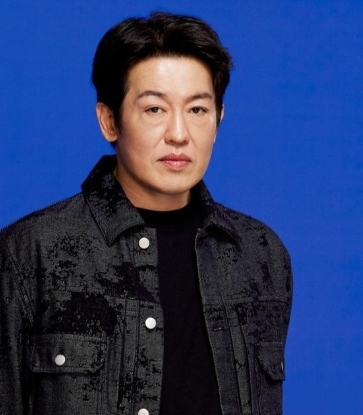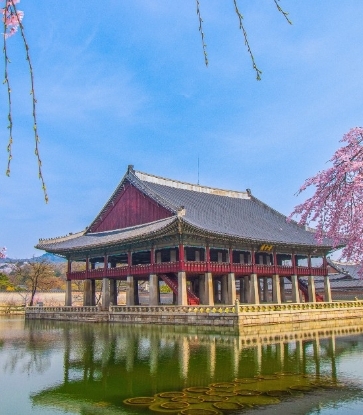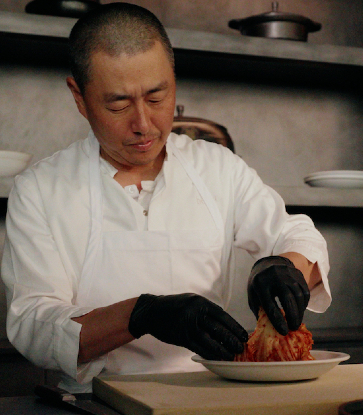Modern Korean restaurant Joo Ok in Seoul, awarded with two Michelin stars, has decided to move to New York’s Korea Town. The Seoul restaurant will close at the end of this month.
It is the first time for a Michelin-starred restaurant in Seoul to move overseas and continue operations. Two-Michelin-starred Jungsik in Seoul runs a restaurant of the same name in New York and Three-Michelin-starred Mosu does so in Hong Kong, but neither shut down their restaurants in Korea’s capital.
Chef Shin Chang-ho of Joo Ok started to think more about the future of his restaurant and his team about three years ago when the Covid-19 pandemic hit. He decided that to gain opportunities to grow further, he needed to make a change.
“I was questioning whether we are stagnant,” Shin said to explain why he made such a decision. “I felt the need to bring forth some new energy so that I, as well as staff members that have also contributed to the making of Joo Ok, can dream bigger and every day bring ourselves a step closer to making that dream come true.”

The one question came to mind: "Why don't we go to New York?"
From the moment he first considered the idea, he started to picture Joo Ok in New York. He talked to Korean chefs already running restaurant businesses in the Big Apple and specified the steps he needed to take to open Joo Ok there. He joined hands with Hand Hospitality, which works with brands including Atomix, Atoboy, Jua and Okdongsik that have been leading the Korean food wave in New York.
He considered two of the most thrilling moments he’s had in his life: one came about 10 years ago when he went to the United States to work and the other came seven years ago when he first opened Joo Ok in Seoul.
As soon as he felt the need for a change, the two moments that got his heart pumping came back to him. Now he’s combining the two to open Joo Ok in New York. Shin shared what details he has for Joo Ok New York with the Michelin Guide Seoul, and said the restaurant’s dishes will be even more Korean in New York than they were in Seoul.
Q. Where is the restaurant going to be located?
It is on the 16th floor of a building in the heart of K-town. It isn’t a neighborhood with many Michelin-starred restaurants so many people have expressed to me their concerns about the location. However, it is the perfect place for us to take on this new challenge. The restaurant can serve as a place of respite from the hustle and bustle of city life and it is on the top floor, so we get a lot of natural sunlight. I am thinking of making a small Korean garden that has a pyeongsang (a large, square bench that almost looks like a low table and is often placed the front yard of Korean homes) to introduce a piece of Korean heritage that’s yet to be widely known in New York. We not only want to serve food but also plan to share the Korean lifestyle that’s been developed over decades and centuries.Q. Is the food you are planning to serve in New York very different from the dishes you served in Seoul?
In the beginning, it may look similar, but will gradually change. I’m going to make jang (fermented sauces essential for cooking Korean food) in the United States and use it to cook dishes in New York. I think people, whether they are Korean or not, now have a better understanding of Korean food and ingredients, compared to seven years ago when I first started Joo Ok. If I use homemade doenjang (fermented soybean paste) instead of commercially-made market-bought doenjang, I think now even the people who didn’t grow up in Korea can tell the subtle difference in flavors, or at least show more interest in learning how the two taste different.I also need to think more about differentiating what I do from what other Korean chefs do. The dishes that have been served so far by chefs of my generation have been relatively similar to one another. It’s time for us to bring forward even more diversity and explore the variety that Korean food has. For one, I’m planning to bring dishes that are popular in different regions of Korea.
Q. Are you thinking about using a separate lab to make Jang?
I’m thinking about creating a lab to make jang in New Jersey. I’m also thinking about building a farm right next to the lab. In the long run, I also plan on making a brewery or distillery where I can make different types of Korean liquor.
At the space in New Jersey, I’m thinking about making doenjang and ganjang (soy sauce). But since I can’t do that by myself, I’m going to work with other Korean chefs in New York, such as chef Ok Dong-sik of restaurant Okdongsik and chef Kang Chang-ki, R&D chef with Hand Hospitality. It will take time until the jang is fermented and aged, but I think it will be so worthwhile.
Q. Do you think people in New York can also taste the difference between different types of doenjang?
Most Koreans can instantly tell whether or not a bowl of doenjang jjigae (doenjang stew) is made with homemade doenjang as they’ve eaten it their whole lives. I think people in New York have had enough bowls of doenjang jjigae or have traveled to Korea enough to at least recognize the subtle difference in flavors. Depending on what yeast we use, doenjang could be sweeter or grainier. Once you are used to eating food made with homemade doenjang, you will be able to tell that the commercially-made versions lack depth. For those who want the flavors of homemade jang but don’t have time to make their own, we will sell jang that we make. We don’t know how soon we can build the system to mass produce jang, but we will see as we try making it there. For now, our goal is to make enough so that we can provide jang to all the chefs in New York who want it to use at their restaurants.Q. What are you going to plant on the farm?
Vegetables like Korean cabbage or radish or anything that’s essential for making kimchi because I plan on making different kimchi dishes. Most of the vegetables are already available in the U.S. but the ones I want might not be available throughout the year.Other vegetables will also be grown at the farm so that I can get fresh sprouts. At Joo Ok I usually use commonly known vegetables but I need the parts that cannot be easily found at a supermarket. For example, there is a vegetable called wonchuri. Instead of using the fully grown plant, I use the flower of it, the flower stalks or the seeds. I want to use the flavors from a certain vegetable but in a different texture or form. To get those parts, I have no other way but to grow the vegetables myself. It will only be chefs who start the farm, but soon we will find either a farmer or an agricultural expert.






















